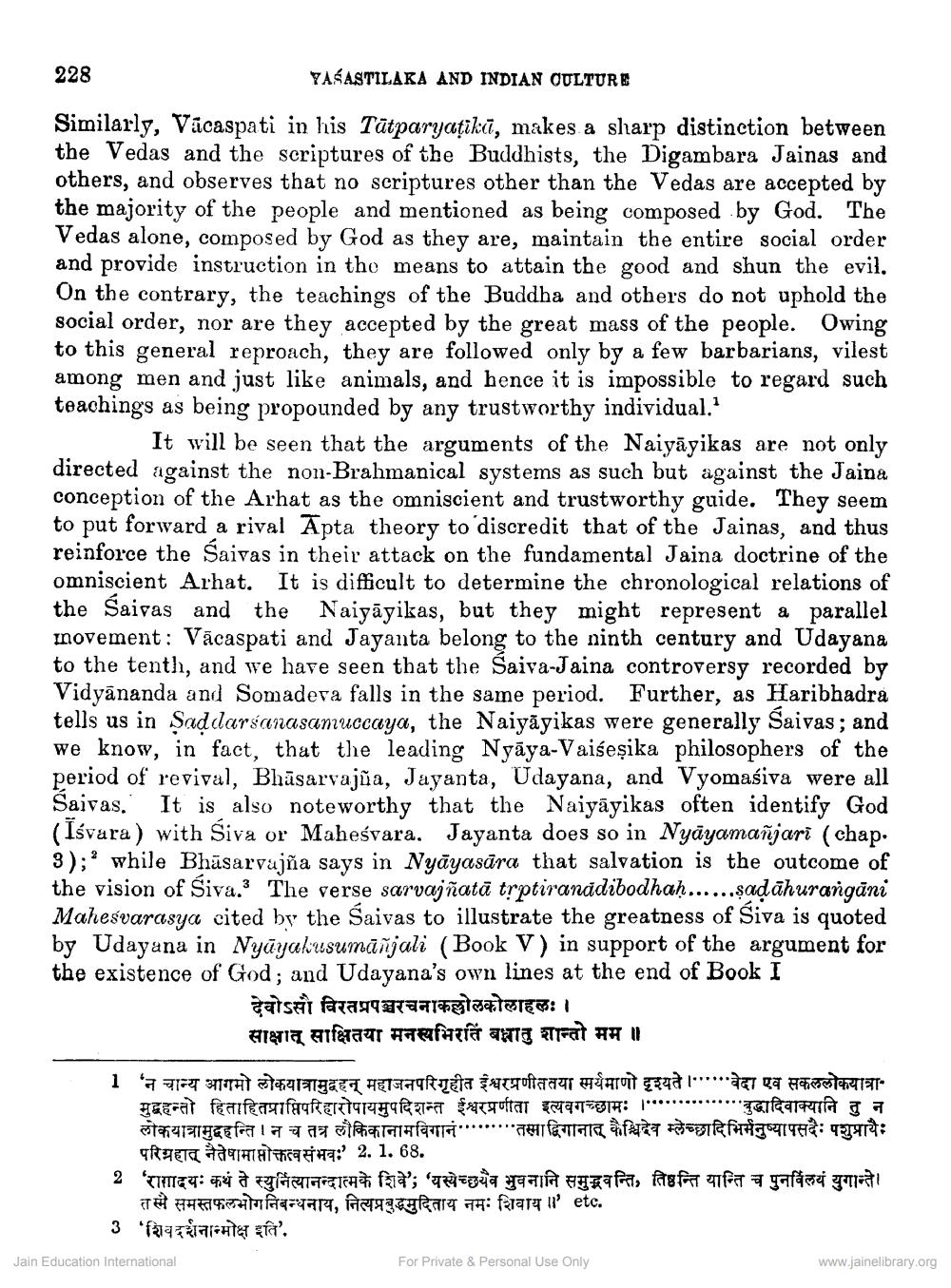________________
228
YASASTILAKA AND INDIAN CULTURE Similarly, Vacaspati in his Tātparyaţika, makes a sharp distinction between the Vedas and the scriptures of the Buddhists, the Digambara Jainas and others, and observes that no scriptures other than the Vedas are accepted by the majority of the people and mentioned as being composed by God. The Vedas alone, composed by God as they are, maintain the entire social order and provide instruction in the means to attain the good and shun the evil. On the contrary, the teachings of the Buddha and others do not uphold the social order, nor are they accepted by the great mass of the people. Owing to this general reproach, they are followed only by a few barbarians, vilest among men and just like animals, and hence it is impossible to regard such teachings as being propounded by any trustworthy individual."
It will be seen that the arguments of the Naiyāyikas are not only directed against the non-Brahmanical systems as such but against the Jaina conception of the Arhat as the omniscient and trustworthy guide. They seem to put forward a rival Apta theory to discredit that of the Jainas, and thus reinforce the Saivas in their attack on the fundamental Jaina omniscient Arhat. It is difficult to determine the chronological relations of the Saivas and the Naiyāyikas, but they might represent a parallel Inovement: Vācaspati and Jayanta belong to the ninth century and Udayana to the tenth, and we have seen that the Saiva-Jaina controversy recorded by Vidyānanda and Somadera falls in the same period. Further, as Haribhadra tells us in Saddarsanasanuccaya, the Naiyãyikas were generally Saivas; and we know, in fact, that the leading Nyāya-Vaiseșika philosophers of the period of revival, Bhāsarvajña, Jayanta, Udayana, and Vyomasiva were all Saivas. It is also noteworthy that the Naiyāyikas often identify God (Isvara) with Siva or Maheśvara. Jayanta does so in Nyāyamañjari (chap. 3);? while Bhāsarvajña says in Nyāyasāra that salvation is the outcome of the vision of Siva. The verse sarvajñatā trptiranadibodhaḥ......sadāhurangāni Mahesvarasya cited by the Saivas to illustrate the greatness of Siva is quoted by Udayana in Nyāyakusumañjali (Book V) in support of the argument for the existence of God; and Udayana's own lines at the end of Book I
देवोऽसौ विरतप्रपञ्चरचनाकल्लोलकोलाहलः । साक्षात् साक्षितया मनस्यभिरतिं बधातु शान्तो मम ॥
'न चान्य आगमो लोकयात्रामुद्वहन् महाजनपरिगृहीत ईश्वरप्रणीततया स्मर्यमाणो दृश्यते ।.."वेदा एव सकललोकयात्रामुद्हन्तो हिताहितप्राप्तिपरिहारोपायमुपदिशन्त ईश्वरप्रणीता इत्यवगच्छामः ।............."बुद्धादिवाक्यानि तु न लोकयात्रामुदहन्ति । न च तत्र लौकिकानामविगानं......."तस्माद्विगानात् कैश्विदेव म्लेच्छादिभिर्मनुष्यापसदैः पशुप्रायः
RHETC #quattrica Fa:' 2. 1. 68. 2 'रागादयः कथं ते स्युनित्यानन्दात्मके शिवे'; 'यस्वेच्छयैव भुवनानि समुद्भवन्ति, तिष्ठन्ति यान्ति च पुनर्विलयं युगान्ते। 19THART, F
e 7: fara li' etc. 3 'fatearater Efa. Jain Education International For Private & Personal Use Only
www.jainelibrary.org




